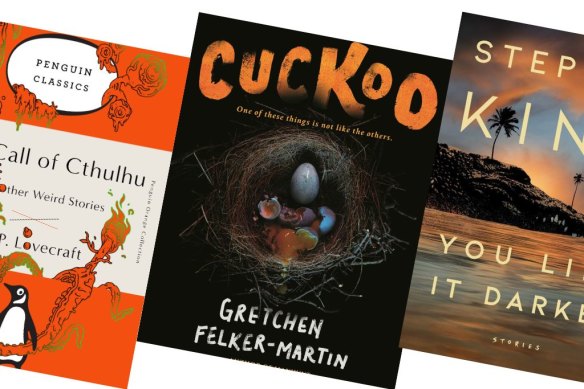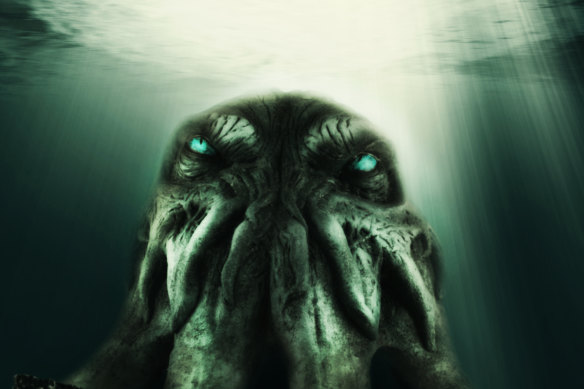This was published 5 months ago
Think a book can’t be scary? Try these four spooky reads
Can a book be as scary as a horror movie? Some may not think so, even if their favourite horror movie’s source material is a book. But while a creepy novel might not give you the kind of jump-scare a film can offer, there’s a certain amount of visual and auditory spoon-feeding from a film.
But reading a scary book ignites your own fear. The reader must create their own images, and we all know how scary our own imaginations can be …

Can these books be as scary as the most frightening films?
The House of Leaves
Mark Z. Danielewski (Penguin)
When this cult postmodern novel was published in 2000, it came complete with a backstory that sounded straight out of a Chuck Palahniuk book: author Mark Z. Danielewski wrote the story – widely regarded as one of the scariest books written – in parts, and printed pages at a time, which he gave to family, friends and left in bars and tattoo parlours in LA, gaining a cult following before he secured a publishing deal. Which ties in nicely with the novel’s Blair Witch-style synopsis: an LA tattoo artist, Johnny Truant, finds a mysterious manuscript when he moves into the apartment of a recently deceased blind man.
The manuscript is an academic criticism of a documentary called The Navidson Record, about Pulitzer Prize-winning photojournalist Will Navidson and his family, who move into a new home which is bigger on the inside than the outside, and contains a doorway to a maze of rooms. When Navidson’s young children wander off, and their voices begin to talk about a creature of darkness and a growing abyss behind a closet door, things get truly creepy. Truant becomes obsessed with the Navdisons’ story, which was recorded on videotapes and interviews, even deciding to finish the old man’s story, scrawled on loose sheets of paper, notebooks and old napkins. As well as an exercise in experimental typography (some pages contain a single word, on others the words are printed in a spiral), The House of Leaves, re-released by Penguin in hardback this month, is a deeply unsettling read.
You Like It Darker
Stephen King (Simon & Schuster)
For 50 years now, Stephen King has been the king of horror, and his classic novels – The Shining, Pet Semetary, The Stand – regularly make best-of lists. But he’s also the master of the unnerving short story, and You Like It Darker is his latest collection. It’s a decent-sized tome, but features just 12 stories, many much longer than your average “short” story. But King has always been one for meticulous scene-setting and suspense-building, and the stories in this 500-page collection feature magic, aliens, ghosts and more, including Rattlesnakes, a sequel of sorts to his 1981 novel Cujo, the one about the rabid Saint Bernard. (Nobody loves a call-back to previous characters as much as King, who has his own “universe” of crossover books and characters.) No spoilers, but this sequel, which takes place in the present day, is a classic King ghost story, marrying the supernatural with grief and paranoia. Other stories in the collection feature friendship, local oddballs and some war-induced PTSD, and like most of his collections, there are Easter eggs scattered throughout for hardcore fans.
Cuckoo
Gretchen Felker-Martin (Macmillan)
Gretchen Felker-Martin’s new novel takes the classic ’80s slasher film trope of teenagers at a rural camp into a new setting, but it’s no less gruesome. The story begins in 1995 as a group of LGBTQ+ teens who have been dragged (literally) to the desert to Camp Resolution, a conversion therapy centre designed to “fix” them through brutal “therapy”. The curriculum at the camp is largely pseudo-science, the physical activities are tantamount to child labour, and the counsellors are physically as well as emotionally abusive. But as well as the horrors and cruelty of Christian America’s attitude to queer people, Cuckoo is also a gory body horror novel; something evil is buried deep in the desert, something that causes each of these teens to have shared dreams of grinning faces and whispered pleas of “come to me”. And whatever the predator is, it stays with each of them for years to come. Sixteen years later, the group has a reunion to finally hunt the monster down. Part Invasion of The Body Snatchers and part The Thing, Cuckoo is truly terrifying, especially Felker-Martin’s gruesome descriptions of people’s faces “opening up” like flower petals. Brrrr.

Cthulhu comes directly from the imagination of horror master H.P. Lovecraft.Credit: iStock
The Call of Cthulhu and Other Weird Stories
H.P. Lovecraft (Penguin)
The most influential horror writer of the 20th century (sorry Stephen King), H.P. Lovecraft should be on every horror fan’s to-read list. Lovecraft wrote mostly short fiction and novellas, but his world-building was, arguably, second to none. And those who haven’t read him before might be surprised to learn it was Lovecraft who created Cthulhu, a gigantic, tentacled cosmic entity, half dragon and half octopus, worshipped by cultists and still very much a part of popular culture today. And just as creepy now as it was when Lovecraft conceived of it a century ago. This collection introduces Cthulhu, and the stories within are a great introduction to his particular style; Lovecraft effectively reinvented the horror genre, moving away from ghosts and witches and instead focusing on the horror of the unknowable. Known as “cosmic horror”, his work often derives horror from the somewhat existential realisation that human interest, law and morality have no meaning in the universe at large. Lovecraft’s sometime flowy prose might have dated somewhat, but his ability to create unease in readers remains terrifyingly relevant.
The Booklist is a weekly newsletter for book lovers from Jason Steger. Get it delivered every Friday.